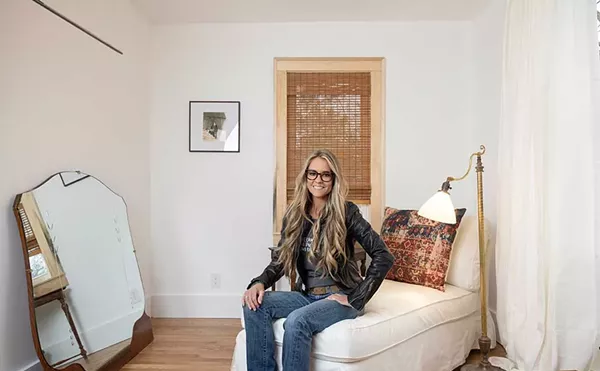
Audio By Carbonatix
[
{
"name": "GPT - Leaderboard - Inline - Content",
"component": "35519556",
"insertPoint": "5th",
"startingPoint": "3",
"requiredCountToDisplay": "3",
"maxInsertions": 100,
"adList": [
{
"adPreset": "LeaderboardInline"
}
]
}
]
Detroiters don’t look up enough. Some of us have worked for decades in a remarkable building downtown and can’t explain why it’s remarkable. There are way too many of us who can’t remember what the building across the street even looks like.
A couple of years ago, two guys on assignment for The New York Times came to Detroit to do a story about the renovation of the Book-Cadillac Hotel. It was a September day. After a long morning of meetings, architecture critic Robert Sharoff and photographer William Zbaren decided to walk around downtown.
They looked up.
“It was like Oz with the lights out,” Zbaren remembers. Neither of them knew that much about Detroit or its architecture. But at every block, they stopped to stare in awe and say, “Who did that? Good lord, what is this?”
When they returned home to Chicago, Sharoff searched the Internet for books about Detroit architecture and was astonished that almost everything, except for last year’s American Institute of Architects guide, was out of print. “I thought, well, that’s it. We need to do a book.”
They contacted Robert Wislow, chairman and CEO of U.S. Equities Realty, one of Compuware’s developers, and he eagerly funded the project. That was the beginning of American City: Detroit Architecture 1845-2005, an informative, gorgeously executed and desperately needed book.
The result is a tall and slender 144-page book showcasing 50 buildings, including museums, schools, monuments and libraries. There are 90 color illustrations; full-page, full-bleed images and double-truck photo spreads set off by ample white space, giving the glorious larger-than-life sculptures room to breathe.
Along with thoroughly researched and well-written captions accompanying every photo, some of which are excerpted below, Sharoff writes an informative introductory essay giving Detroit architecture historical, artistic and social context.
American City is not a guide book or textbook. It’s sort of a “best of the best” in Detroit architecture, organized chronologically according to each major design period. They hadn’t planned it that way, but in doing the legwork, Sharoff realized that Detroit, unlike other cities, didn’t have masterpieces in merely one or two eras; there are impressive commercial and civic buildings spanning all of them. “It’s like there’s uranium in the ground or something,” Zbaren says. “There is just such consistently good design.”
Beginning in June 2004, the pair spent a year commuting between Chicago and Detroit, holing up with their fax machine, computers and inflatable airbed in temporary spaces, including an office suite in the Guardian Building, where they took cold showers in the janitor’s bathroom in a second subbasement. They also stayed in a 100-year-old Victorian house in Corktown with no plumbing or furnace before they finally ended up in the recently renovated Kales Building in Grand Circus Park.
Zbaren has only been a photographer for three years, but with his 35 mm digital camera, he approached his subjects as an artist, willing to spend the time it takes to catch a building when it really works, attempting to convey it the way the mastermind originally envisioned it.
He says one incredible illusion is the zigzag pattern that runs around the Penobscot Building. “Architects put all these tricks in, and you can see that magic on a lot of Detroit buildings. If you catch the Penobscot in the springtime, around 11 a.m., the sun comes over the city and shoots down Griswold Avenue. It throws a light that creeps down the building, striking the pattern and blurring it out. For only about six to eight minutes, it’s like Times Square. The building straightens its back and rises up.”
He had another great experience with the Coleman A. Young Community Center. “The first time I saw it was in the terrible full-blown flat light of the morning. But a friend told me to go back and catch it in afternoon. He was right; it looked like something in the Sahara desert.”
In fact, most of Zbaren’s photos are a result of repeated visits to one location, which is why the project took a lot longer than the three months originally proposed.
For the Ren Cen, he wound up shooting from the roof of Solidarity House, the UAW headquarters, 3 miles away on East Jefferson Avenue. The point was getting a shot where the building — which to his eye reflects the weather like a mood ring — didn’t overpower the city.
And he spent more than a year trying to get the right shot from Ludwig Mies van der Rohe’s Lafayette Towers: “It was fall. I was pressed up against a chain link fence trying to get far back enough. There were these tree branches coming down in front of me. Finally, I tied the branches back. I got a shot I liked, but I spent all winter with 2 percent of my gut telling me something was off. Come spring, I was sitting in his perfect marble lobby, in which every line comes together, and looked through the windows to the chaos of the world. That’s when I realized Mies is about observing and embracing chaos from the perspective of extreme order. I knew I needed those tree branches in the shot, but I just needed the leaves barely budding.”
It’s hard to believe that so many renowned architects worked in Detroit: Daniel Burnham, Stanford White, Cass Gilbert, Frank Lloyd Wright, Minoru Yamasaki and Philip Johnson included. But in doing research for the book, Sharoff enjoyed discovering a couple of architects who are native Detroiters. In his mind, Wirt Rowland’s Guardian Building is as good as the Chrysler Building. Combining Native American, pre-Columbian, gothic and art deco influences with a cathedral floor plan, including a nave and an apse, the Guardian Building celebrates eclecticism.
“Rowland did stuff that no modernist would ever do,” Sharoff says. “He combined influences in a way that is really thrilling, not to mention forbidden by orthodoxy.” Sharoff mentions the mainly gothic and medieval Buhl Building as another interesting high-rise, with relief statues of Indian chiefs in the entryway.
Some experiences for the journalists were humbling. Zbaren only recently found out that Isamu Noguchi’s fountain, located in Hart Plaza, has nozzles in a barrel that spray a pressurized mist, forming a cloud that billows about 25 feet. It sounds like a thunderstorm, and when the sun strikes it, it creates a rainbow. Zbaren says, “In 1979, when the city was in an economic nightmare, Noguchi gave Detroit a rainbow-making machine. When I found that out, I was short-circuited.”
According to Sharoff and Zbaren, what makes Detroit so interesting is that its architects have looked to the East Coast for inspiration. In a lot of ways, you could transplant our buildings in lower Manhattan, and they’d fit New York’s proportions. They say we’re a Midwestern city with extreme beaux-arts elegance and art deco attitude, and we’re also modernist to the max.
Whoever came up with the title of the book — American City — deserves some recognition. Maybe it was the folks at Wayne State University Press. But it likely could have been Sharoff and Zbaren, who say they started out feeling like explorers and left feeling like Detroit belonged to them in a very personal way. This city can certainly do that to you. Whoever it was must have known that our community both needs the gentle reminder and deserves to make such a boastful declaration.

Coleman A. Young Community Center
2757 Robert Bradby Drive
William Kessler and Associates, 1981
While officially attributed to William Kessler, this perfectly scaled Modernist pyramid is largely the work of the talented husband-and-wife team of chief designer James Cardoza and interior designer Carolyn Cardoza. The soaring two-story lobby with its bright green ceiling is a particular delight.

Guardian Building (Union Trust Building)
500 Griswold St.
Smith, Hinchman, and Grylls (Wirt Rowland), 1929
Restoration by SmithGroup, 2000
The Guardian represents the high-water mark of 1920s ebullience in Detroit with a floor plan resembling that of a medieval cathedral and a color palette like no other in the city. “We no longer live in a leisurely age,” Wirt Rowland said at the time. “What we see we must see quickly in passing, and the impression must be immediate, strong, and complete. Color has this vital power.”

Kresge-Ford Building
245 E. Kirby St., College for Creative Studies
William Kessler and Associates, 1975
Detroit’s only Metabolist building. The Japanese Metabolist architects of the 1960s and 1970s believed that buildings should have no beginning or end, that they should be endlessly expandable in every direction. Kessler, a Harvard-trained Modernist who drew on a wide range of influences during his long career, used this concept for a building that manages to be simultaneously modern, practical, and witty.

Turkel House
2760 W. Seven Mile Rd.
Frank Lloyd Wright, 1956
In 1954 on the subject of affordable housing for returning GIs, Wright said, “I have given it to him and he doesn’t know it ... in what I call the Usonian Automatic.” He also explained how easy building a house can be using “Usonian” techniques. “The GI can go in his back road ... he’s got sand there ... get himself some steel rods and cement, make the blocks and put the blocks together ... you can build your own house.” The latter is Wright at his most endearingly absurd. The house is constructed of more than three dozen different styles of concrete blocks, all custom designed by the architect. Whatever else it is, it’s no do-it-your-selfer.

Fisher Building
3011 W. Grand Blvd.
Albert Kahn, 1929
The first of what was originally projected to be three towers, the Fisher — commissioned by the seven Fisher brothers of Fisher Body fame — is generally considered to be Albert Kahn’s finest non-industrial structure. The Fishers were intent on establishing a new business district three miles north of downtown and wanted, according to Kahn, “a thoroughly high class building.” They got one. The L-shaped structure includes offices, a shopping arcade, and a 2,000-plus-seat theater. In the three-story, barrel-vaulted lobby are 40 different kinds of marble, enough, said one critic, to “dazzle the most jaded Roman emperor.”

Chauncey Hurlbut Memorial Gate
East Jefferson Avenue at Cadillac Boulevard (Waterworks Park)
Herman Brede and Gustave Mueller, 1894
Chauncey Hurlbut, longtime president of the Board of Water Commissioners, left his entire estate to the city to be used for the beautification of Waterworks Park. The result was this lyrical Beaux-Arts gate, which at one time also contained a library. A bust of Hurlbut once occupied the pedestal in the center archway.

R. Hirt Jr. Co. Building
2468 Market St.
Architect unknown, 1893
Merchant Rudolph Hirt Jr. constructed this Romanesque structure as a combination store and residence in the heart of Eastern Market, the city’s old wholesale district. This is county seat architecture. One can imagine it across the square from the courthouse just about anywhere in the Midwest. The family continues to operate the store, which, over the years, has expanded into the top-floor residential apartment.

Dime Building
719 Griswold St.
D. H. Burnham and Co., 1910
Renovation by Barton Malow Design, 2001
“Uncle Dan was an impresario,” said Frank Lloyd Wright, capturing the essence of Daniel Burnham’s talent as well as the way in which he was regarded by fellow architects. More than anything, Burnham was a synthesizer who specialized in combining the structural innovations of the Chicago school with the stylistic demands of Beaux-Arts Classicism. The Dime was the third of four D. H. Burnham and Co. commissions in Detroit. The first was the 1896 Majestic Building, now demolished. The second was the 1909 Ford Building, which stands a block south of the Dime on Griswold Street. The third, the David Whitney Building on the south side of Grand Circus Park, was completed three years after Burnham’s death in 1912.

Detroit Cornice and Slate Company
733 St. Antoine St.
Harry J. Rill, 1897
Restoration and addition by William Kessler and Associates, 1999
A cornice made of pressed and hammered sheet metal was commonplace in the nineteenth century, but an entire facade was much less so. Harry Rill, known primarily as a church architect, took his cues from his client, in this case a manufacturer of pressed and hammered steel building ornament.

McGregor Memorial Conference Center
495 Ferry Mall, Wayne State University
Minoru Yamasaki and Associates, 1958
In a trip around the world in the late 1950s, Minoru Yamasaki, previously a strict Modernist in the style of Mies van der Rohe, found himself “strongly affected by the humanistic qualities of the historical buildings.” Returning to Detroit, he resolved to strike out in a new direction, and his future buildings became more consciously expressive and idiosyncratic. The McGregor Memorial Conference Center is a masterpiece — a deceptively simple two-story white travertine structure divided into halves by a glass atrium. The building’s exposed V-shaped ceiling beams affect other design elements, from the diamond-patterned atrium skylight to the dazzling aluminum doors. The structure is both dynamic and serene, a combination that Mies struggled to achieve. The landscaping, also by Yamasaki, features groves of trees and an exquisite water garden.

Detroit Receiving Hospital
4201 St. Antoine St.
William Kessler and Associates, Zeidler Partnership, and Giffels Associates, 1979
William Kessler’s work, says the architect Eric Hill, has “the sleekness and finish of a jet fighter,” an apt description of this Modernist complex clad in aluminum and porcelain. An advocate of public art, Kessler chose the works for the hospital’s extensive collection.

Belle Isle Conservatory
Belle Isle
Albert Kahn, 1904
Potted palms were an enduring obsession of the Gilded Age, especially when under glass. The models for this and numerous other conservatories of the period were England’s Crystal Palace and the Palm House at Kew Gardens, both of which date from the mid-1800s. Albert Kahn, who spent a year in Europe sketching notable buildings at the beginning of his career, was undoubtedly familiar with these Victorian icons.




